Troop 33 Handbook: Advancement
Joining Requirements
These requirements must be met to join Troop 33.
- Complete the fifth grade, or be 11 years old, or have
earned the Arrow of Light Award, but be younger than 18
years old.
- Submit a completed Scout application and health
history signed by your parent or guardian. SEE QUICK
START FORM INSIDE FRONT COVER.
- Repeat the Pledge of Allegiance (page 468 of the
Scout Handbook).
- Demonstrate the Scout sign, salute, and handclasp (pages
564-565).
- Demonstrate tying the square knot (joining knot) (pages
132-133).
- Understand and agree to live by the Scout Oath or
promise, Law, motto, and slogan, and the Outdoor Code
(pages 5-9, 55).
- Describe the Scout badge (page 565).
- With your parent or guardian, complete the exercises in
the pamphlet "How to Protect Your Children from
Child Abuse and Drug Abuse."
- Participate in a Scoutmaster conference.
- With only a few key exceptions, a parent may not sign-off for their own child's
advancements. Please consult with Dave Moore before doing so.
Rank Advancement
Scouting uses a self-paced advancement program, in which each
Scout has the opportunity to advance through five ranks to the
sixth, and highest rank, the rank of Eagle Scout. Details of the
requirements that must be met to satisfy each of the ranks of
Tenderfoot, Second Class, First Class, Star, Life and Eagle ranks
can be found in the Scout Handbook, and are also listed in
this Troop Handbook. A Scout can check his advancement status
through the postings on the Troop web site or by consulting with
the Advancement Chairman.
Every Scout should take his handbook to every meeting,
campout, swim, and service project, or other activity where he
might pass some thing. If a requirement doesn't get signed off as
soon as it is passed, it may be forgotten, at which point the
Scout will have to do that requirement again.
A Scout should follow these procedures for obtaining and
recording his rank advancements:
- Meet the requirements for the advancement or award,
including the Scoutmaster's Conference and Board of
Review, as set forth in the Scout Handbook.
- Have your Scout Handbook signed by the appropriate adult
leader(s).
- Show your Scout Handbook or other advancement/award
paperwork to the Advancement Chairman. It is A SCOUT'S
RESPONSIBILITY to show his completed advancement or award
paperwork to the Advancement Chairman. A Scout should not
depend on his parent or anyone else to do this for him.
If the Advancement Chairman does not have your rank
advancement or award posted to the his/her records you
have not yet earned the advancement or award. Remember,
each Scout is responsible for showing his completed
paperwork to the Advancement Chairman!!!
A Scout's advancement is recorded in his Scout Handbook
(pages 438-447). A Scout is responsible for asking the
Scoutmaster or his assistants to sign his handbook as soon as he
completes any requirement. SCOUTS SHOULD SAFEGUARD THEIR
HANDBOOK BY CLEARLY MARKING THEIR NAME ON THE OUTSIDE EDGE AND
PROTECTING IT FROM "THE ELEMENTS". REMEMBER, ALL
HANDBOOKS LOOK ALIKE FROM THE OUTSIDE!
Note that the BSA modified certain of the requirements for
achieving the Tenderfoot, Second Class, First Class, Star, Life,
and Eagle ranks. The new requirements are reflected below. The
changes are effective January 1, 1999, but there was a transition
period from January 1-April1, 1999. All new rank requirements
must be met for any ranks earned as of April 1, 1999, or later.
Merit Badges and Awards
Each Rank above First Class requires that a Scout earn a
minimum number of merit badges, including a specified minimum
number of Eagle-required Merit Badges (twelve in all) in order to
earn the rank. Many of these are offered by Troop Counselors on a
scheduled basis during the year. Others are attainable at Camp
Ajawah, Merit Badge Clinics, or on an individual basis from BSA
Merit Badge Counselors. Announcements and sign ups for merit
badge activities generally take place at Troop meetings.
All Scouts should comply with the following procedures for
Merit Badge counseling. Your assistance in this will help
maintain our standards and eliminate the possibility of
disappointment to the Scout.
To Qualify for a Merit Badge:
- The Scout selects a Merit Badge that interests him, or
that is necessary for his next rank advancement.
- The Advancement Chairman or a Scoutmaster will assign a
Merit Badge Counselor and furnish the merit badge card
(sometimes called "blue card," although all are
not blue) before beginning any work on the Merit Badge.
Merit Badge Counselors are registered members of the
Troop Committee, parents and/or other adults who have
knowledge and experience in a particular area, and have
registered with the Viking Council.
- In the case of merit badges offered by the Troop, it is
not necessary to obtain the Scoutmaster's permission (and
signature on the merit badge card) prior to starting work
on the badge. In all other cases, a Scout should obtain
the Scoutmaster's permission (and signature) before
beginning.
- Coaching sessions and interim reporting, if required,
continue between the Counselor and the Scout until the
Counselor is satisfied that the Scout has completed all
the requirements for the Merit Badge.
- The Counselor signs the Merit Badge application card. If
the course is Troop offered, the Scout has the
Scoutmaster (or Assistant Scoutmaster) sign the card. The
Scout then returns the card to the Advancement Chairman
for recording. Especially in the case of merit badges
earned outside the Troop, a Scout should take
care to safeguard the documentation he receives of his
work; if lost, a Scout may have to repeat the work to
earn the badge.
- At the next appropriate Court of Honor, the Scout will
receive the Merit Badge and an achievement card.
The Scout Handbook lists currently available Merit Badges
(over 125). For specific information, you should obtain a Merit
Badge book (pamphlet) from the Troop library or Scout Shop, which
gives details and step-by-step help on meeting the requirements
of a particular Merit Badge. Also available at the Scout Shop is
a handy "Scout Requirements" book, which lists all
the Merit Badges and their requirements.
Scoutmaster Conference and Board of Review
General:
Each advancement requires a Scoutmaster Conference and a Board
of Review. At the Scoutmaster Conference, the Scoutmaster reviews
the requirements for the rank and the Scout's performance of
those requirements. This conference should establish a good
working relationship between the Scout and the Scoutmaster of the
Troop. It is an opportunity for the Scoutmaster to meet one on
one with each Scout in order to set goals, discuss interests and
communicate regarding the Scout's interaction with the Patrol and
Troop. A Scoutmaster Conference is required for each rank
advancement, and whenever requested by the Scoutmaster.
A Board of Review is conducted by a three-member panel
composed of adult Troop Committee Members. Board of Review
procedures follow the guidelines set forth by Boy Scouts of
America. In the case of a Board of Review for Eagle, the District
Advancement Chairman will designate a District Advancement
Committee member to serve on the Board of Review. Final approval
of all Eagle Awards is given only by the National Council, Boy
Scouts of America.
In a Board of Review, the panel asks detailed questions to
determine the quality of the Scout's experience. Other questions
pertaining to "Scout Spirit," leadership abilities,
service work or other aspects of Scouting are normal. A Board of
Review is not a retest of the achievement requirements which have
already been approved by the Scoutmaster.
Boards of Review and Scoutmaster conferences are scheduled
usually for the first Monday meeting of the month. A Board of
Review should be scheduled at least two weeks prior to each Court
of Honor. It is the Scout's responsibility to arrange a time for
both the Scoutmaster Conference and Board of Review. A Scout
should present his handbook to the Advancement Chairman and
verify that Troop records reflect his completion of all other
necessary requirements, at the time the Scout requests the
Advancement Chairman to schedule a Board of Review.
At the Board of Review & Scoutmaster Conferences:
The Scout must present himself at the scheduled time in FULL
"CLASS A" UNIFORM with his Scout Handbook properly
signed for the requirements for rank to which he is advancing.
Court of Honor
Advancement is recognized at a formal Troop Court of Honor
held twice a year, once in December, and once in June. The Court
of Honor provides an opportunity for Scouts to be acknowledged
for their work. Families are strongly encouraged to attend as the
Court of Honor is a special occasion and, in the case of Eagle,
parents are asked to stand with their Scout as he receives his
rank.
Troop 33 organizes two types of ceremonies to recognize
advancement achievements: Court of Honor and "Eagle"
Scout Court of Honor.
The Court of Honor addresses Merit Badges, General
Information, Announcements, various Award Presentations, and Rank
Advancements. The Court of Honor generally takes place in the
Refrectory of Westminster Church. The calendar reflects the Court
of Honor start times.
The "Eagle" Scout Court of Honor addresses Rank
Advancements and the "Eagle" Scout Ceremony. It takes
place in the Church Sanctuary. The Ceremony starts immediately
following the Court of Honor. In order to give the Scouts the
recognition they deserve, all family's are asked to stay for the
Eagle Ceremony. A Scout's "Eagle" Scout Court of Honor
date is determined by the date when all of a Candidate's paper
work has been completed. A Scout who completes his rank in
between scheduled Eagle Scout Court of Honor dates will be expect
to wait until the next scheduled Eagle Scout Court of Honor to be
honored for his achievement and publicly receive his rank award.
Dates are reflected in the calendar, but are subject to change.
Contact any of the Committee Members with questions.
Tenderfoot Requirements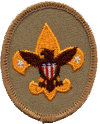
- Present yourself to your leader, properly dressed, before
going on an overnight camping trip. Show the camping gear
you will use. Show the right way to pack and carry it.
- Spend at least 1 night on a patrol or troop campout.
Sleep in a tent you have helped pitch on a ground bed you
have prepared.
- On the campout, assist in preparing and cooking one of
your patrol's meals. Tell why it is important for each
patrol member to share in meal preparation and cleanup,
and explain the importance of eating together.
- Demonstrate how to whip and fuse the ends of a
rope.
- Demonstrate you know how to tie the following
knots, and what their uses are: two half hitches
and a tautline hitch.
- Explain the rules of safe hiking, both on the highway and
cross-country, during the day and at night. Explain what
to do if you are lost.
- Demonstrate how to display, raise, lower, and fold the
American flag.
- Repeat from memory and explain in your own words the
Scout Oath, Law, motto and slogan.
- Know your patrol name, give the patrol yell, and describe
your patrol flag.
- Explain why we use the buddy system in Scouting.
- Record your best in the following tests
(currently and 30 days later):
Pushups____Pullups____Situps____ Standing long
jump____ft.____in. Run/walk ¼ mile____
- Show improvement in the activities listed above
after practicing for 30 days.
- Identify local poisonous plants; tell how to treat for
exposure to them.
- Demonstrate the Heimlich maneuver and tell when
it is used.
- Show first aid for the following:
- Simple cuts and scratches.
- Blisters on the hand and foot.
- Minor burns or scalds (first degree).
- Bites or stings of insects and ticks.
- Poisonous snakebite.
- Nosebleed.
- Participate in a Scoutmaster conference with Scout's
Patrol Asst. Scoutmaster.
- Board of review completed _________________
Second Class Requirements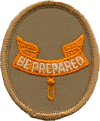
- Demonstrate how a compass works and how to orient
a map. Explain what map symbols mean.
- Using a compass and a map you've drawn, take a
5-mile hike (or 10 miles by bike) approved by
your adult leader and your parent or guardian.*
- Since joining, have participated in five separate
troop/patrol activities (other than troop/patrol
meetings), two of which included camping
overnight.
- On one of these campouts, select your patrol site
and sleep in a tent that you pitched.
- On one campout, demonstrate proper care,
sharpening, and use of knife, saw, and ax.
- Use the tools listed above to prepare tinder,
kindling, and fuel for a cooking fire.
- Light the cooking fire. Assist with the meal
preparation and cleanup.
- Discuss when it is appropriate to use a cooking
fire and a lightweight stove. Discuss the safety
procedures for using both.
- Demonstrate how to light a fire and a lightweight
stove.
- On one campout, plan and cook over an open fire
one hot breakfast or lunch for yourself,
selecting foods from the four basic food groups.
Explain the importance of good nutrition. Tell
how to transport, store, and prepare the foods
you selected.
- Participate in flag ceremony for your school, religious
institution, chartered organization, community, or troop
activity.
- Participate in an approved (minimum of 1 hour) service
project.
- Identify or show evidence of at least 10 kinds of wild
animals (birds, mammals, reptiles, fish, mollusks) found
in your community.
- Show what to do for "hurry" cases of
stopped breathing, serious bleeding, and internal
poisoning.
- Prepare a personal first aid kit to take with you
on a hike.
- Demonstrate first aid for the following: ·
Object in eye · Bite of a suspected rabid animal
· Puncture wounds from a splinter, nail and
fishhook · Serious burns (second degree) · Heat
exhaustion · Shock
- Tell what precautions must be taken for a safe swim.
- Demonstrate your ability to jump feet first into
water over your head in depth, level off and swim
25 feet on the surface, stop, turn sharply,
resume swimming, then return to your starting
place.**
- Demonstrate water rescue methods by reaching with
your arm or leg, by reaching with a suitable
object, and by throwing lines and objects.**
Explain why swimming rescues should not be
attempted when a reaching or throwing rescue is
possible, and explain why and how a rescue
swimmer should avoid contact with the victim.
- Participate in a school, community, or troop program on
the dangers of using drugs, alcohol, and tobacco, and
other practices that could be harmful to your health.
Discuss your participation in the program with your
family.
- Show Scout spirit.
- Participate in a Scoutmaster conference with Scout's
Patrol Asst. Scoutmaster.
- Board of review completed. __________________.
* If you use a wheelchair or crutches, or if it is difficult
for you to get around, you may substitute "trip" for
"hike." ** This requirement may be waived by the Troop
Committee for medical or safety reasons.
First Class Requirements
- Demonstrate how to find directions during the day and at
night without using a compass.
- Using a compass, complete an orienteering course that
covers at least 1 mile and requires measuring the height
and/or width of designated items (tree, tower, canyon,
ditch, etc.).
- Since joining, have participated in ten separate
troop/patrol activities (other than troop/patrol
meetings), three of which included camping overnight.
- Help plan a patrol menu for one campout -
including one breakfast, lunch and dinner - that
requires cooking. Tell how the menu includes the
four basic food groups and meets nutritional
needs.
- Using the menu planned in requirement 4a, make a
list showing the cost and food amounts needed to
feed three or more Scouts and secure the
ingredients.
- Tell which pans, utensils, and other gear will be
needed to cook and serve these meals.
- Explain the procedures to follow in the safe
handling and storage of fresh meats, dairy
products, eggs, vegetables, and other preishable
food products. Tell how to properly dispose of
camp garbage, cans, plastic containers, and other
rubbish.
- On one campout, serve as your patrol's cook.
Supervise your assistant(s) in using a stove or
building a cooking fire. Prepare a breakfast,
lunch, and dinner planned in requirement 4a. Lead
your patrol in saying grace at the meals, and
supervise cleanup.
- Visit and discuss with a selected individual approved by
your leader (elected official, judge, attorney, civil
servant, principal, teacher) your constitutional rights
and obligations as a U.S. citizen.
- Identify or show evidence of at least 10 kinds of native
plants found in your community.
- Demonstrate tying the timber hitch and clove
hitch and their use in square, shear, and
diagonal lashings by joining two or more poles or
staves together.
- Use lashing to make a useful camp gadget.
- Demonstrate tying the bowline knot and describe
several ways it can be used.
- Demonstrate bandages for injuries on the head,
the upper arm, and collarbone.
- Show how to transport by yourself, and with one
other person, a person:
- from a smoke-filled room
- with a broken leg, for at least 25 yards.
- Tell the five most common signs of a heart
attack. Explain the steps (procedures) in
cardiopulmonary resuscitation (CPR).
- Tell what precautions must be taken for a safe
trip afloat.
- Successfully complete the BSA swimmer test.*
- Demonstrate survival skills by leaping into deep
water wearing clothes (shoes, socks, swim trunks,
long pants, belt, and long-sleeved shirt). Remove
shoes and socks, inflate the shirt, and show that
you can float using the shirt for support. Remove
and inflated the pants for support. Swim 50 feet
using the inflated pants for support, then show
how to reinflate the pants while using them for
support.*
- With a helper and a practice victim, show the
line rescue both as a tender and as a rescuer.
(The practice victim should be approximately 30
feet from shore in deep water.)
- Show Scout spirit by living the Scout Oath(Promise) and
Scout Law in your everyday life.
- Participate in a Scoutmaster conference with Scout's
Patrol Asst. Scoutmaster.
- Board of review completed ____________________.
* This requirement may be waived by the Troop Committee for
medical or safety reasons.
Star/Life/Eagle
The ranks of Star, Life and Eagle require earning a certain
number of merit badges, serving in a position of responsibility
in the troop, and being of service to others. Of the more than
120 merit badges available, the following 12 are the required
list* of merit badges for Eagle:
| First Aid |
Citizenship in the Community |
| Citizenship in the Nation |
Citizenship in the World |
| Communications |
Personal Management |
| Environmental Science |
Personal Fitness |
| Camping |
Family Life |
| Emergency Preparedness |
OR Lifesaving |
| Cycling OR Swimming |
OR Sports |
| *Note: Changes to the list of Eagle required merit
badges will be made effective as of January 1, 1999, with
either the old or the new list effective until April 1,
1999. An explanation of changes will be published by the
Troop at a later date. STAR RANK 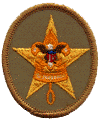
- Be active in your troop and patrol for at least 4
months as a First Class Scout.
- Demonstrate Scout spirit by living the Scout Oath
and Scout Law in your everyday life.
- Earn six merit badges including any four from the
required list for Eagle.
- While a First Class Scout, take part in service
projects totaling at least 6 hours of work. These
projects must be approved by your Scoutmaster.
- While a First Class Scout, serve actively 4
months in one or more of the following positions
of responsibility (or carry out a
Scoutmaster-assigned leadership project to help
the troop): patrol leader, senior patrol leader,
assistant senior patrol leader, den chief,
scribe, librarian, historian, quartermaster,
bugler, chaplain aide, instructor, junior
assistant Scoutmaster, troop guide.
- After reviewing readiness with the Patrol ASM,
take part in a Scoutmaster conference with the
Scoutmaster or his specially-designated ASM.
- Complete Board of Review.
LIFE RANK 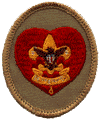
- Be active in your troop and patrol for at least 6
months as a Star Scout.
- Demonstrate Scout spirit by living the Scout Oath
and Scout Law in your everyday life.
- Earn five more merit badges (so that you have 11
in all), including any three more from the
required list for Eagle.
- While a Star Scout, take part in service projects
totaling at least 6 hours of work. These projects
must be approved by your Scoutmaster.
- While a Star Scout, serve actively for 6 months
in one or more of the positions of responsibility
(or carry out a Scoutmaster-assigned leadership
project to help the troop): patrol leader, senior
patrol leader, assistant senior patrol leader,
den chief, scribe, librarian, historian,
quartermaster, bugler, chaplain aide, instructor,
junior assistant Scoutmaster, troop guide.
- After reviewing readiness, take part in a
Scoutmaster conference with the Scoutmaster or
his specially-designated ASM.
- Complete Board of Review.
EAGLE PROJECT REVIEW
The Troop Committee has delegated to the Eagle Project
Review Committee, (appointed by the Troop Committee
Chairman), the responsibility for working with each
individual Eagle Scout candidate in determining the
scope, nature, and process for establishing and executing
his Eagle Scout project. This committee will work with
the Advancement Chairman in order to be sure that
projects meet the criteria of the BSA, as well as Troop
33. It is the objective of this review committee to
assist the Scout, giving guidance and suggestions, as
well as, ensuring the integrity of the Scout project.
EAGLE RANK 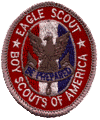
- Be active in your troop and patrol for at least 6
months as a Life Scout.
- Demonstrate Scout spirit by living the Scout Oath
and Scout Law in your everyday life.
- Earn a total of 21 merit badges (10 more than you
already have), including 12 from the list of
merit badges required for Eagle.
- While a Life Scout, serve actively for a period
of 6 months in one or more of the following
positions of responsibility: senior patrol
leader, assistant senior patrol leader, chaplain
aide, den chief, instructor, junior assistant
Scoutmaster, librarian, patrol leader,
quartermaster, scribe, senior patrol leader,
troop guide.
- While a Life Scout, plan, develop, and give
leadership to others in a service project helpful
to any religious institution, any school, or your
community. (The project should benefit an
organization other than Scouting.) The
project idea must be approved by the organization
benefiting from the effort, your Scoutmaster and
Troop Committee, and by the council or district
before you start. You must use the Eagle Scout
Service Workbook in meeting this requirement.
- Take part in a Scoutmaster conference with the
Scoutmaster or his specially-designated ASM.
- Complete Board of Review.
|
Return to the Troop 33
Handbook



